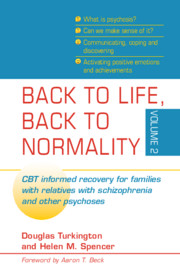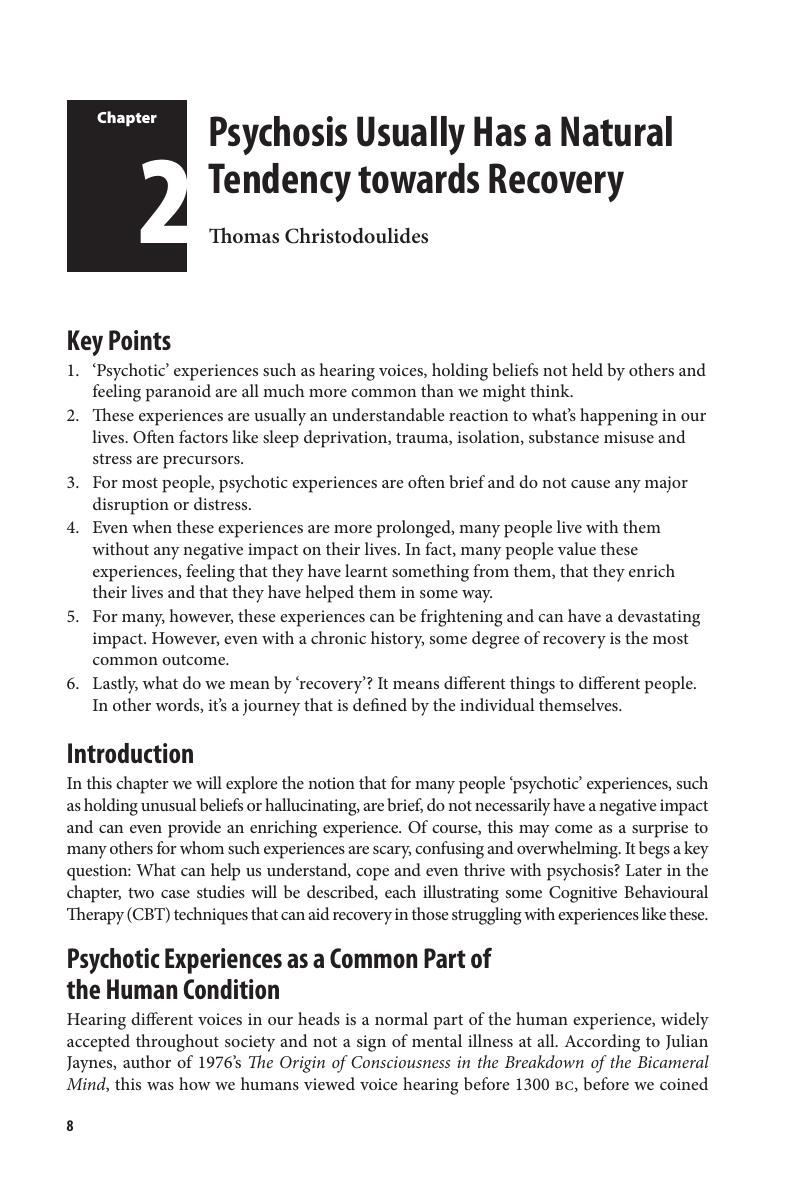 Back to Life, Back to Normality
Back to Life, Back to Normality Book contents
- Back to Life, Back to Normality Volume 2
- Back to Life, Back to Normality Volume 2
- Copyright page
- Contents
- Endorsements
- Testimonials
- Contributors
- Foreword
- Preface
- Chapter 1 What Is Psychosis? What Is Schizophrenia?
- Chapter 2 Psychosis Usually Has a Natural Tendency towards Recovery
- Chapter 3 Positive Aspects of Psychosis
- Chapter 4 When Can Psychosis Escalate and Will Medicines Help?
- Chapter 5 Making Sense of Psychosis
- Chapter 6 What If the Psychosis Is Linked to Trauma?
- Chapter 7 The Five Pillars of Caring for Psychosis
- Chapter 8 Effective Coping
- Chapter 9 Caring about Delusions and Unusual Beliefs
- Chapter 10 My Story of Psychosis and CBT
- Chapter 11 Dealing with Visions
- Chapter 12 Compassion-Focused Approaches for Clients, Families and Health Care Providers
- Chapter 13 Improving Self-Care, Attention/Memory, Motivation and Social Functioning
- Chapter 14 Where Can We Learn More?
- Index
- References
Chapter 2 - Psychosis Usually Has a Natural Tendency towards Recovery
Published online by Cambridge University Press: 16 November 2018
- Back to Life, Back to Normality Volume 2
- Back to Life, Back to Normality Volume 2
- Copyright page
- Contents
- Endorsements
- Testimonials
- Contributors
- Foreword
- Preface
- Chapter 1 What Is Psychosis? What Is Schizophrenia?
- Chapter 2 Psychosis Usually Has a Natural Tendency towards Recovery
- Chapter 3 Positive Aspects of Psychosis
- Chapter 4 When Can Psychosis Escalate and Will Medicines Help?
- Chapter 5 Making Sense of Psychosis
- Chapter 6 What If the Psychosis Is Linked to Trauma?
- Chapter 7 The Five Pillars of Caring for Psychosis
- Chapter 8 Effective Coping
- Chapter 9 Caring about Delusions and Unusual Beliefs
- Chapter 10 My Story of Psychosis and CBT
- Chapter 11 Dealing with Visions
- Chapter 12 Compassion-Focused Approaches for Clients, Families and Health Care Providers
- Chapter 13 Improving Self-Care, Attention/Memory, Motivation and Social Functioning
- Chapter 14 Where Can We Learn More?
- Index
- References
Summary

- Type
- Chapter
- Information
- Back to Life, Back to NormalityCBT Informed Recovery for Families with Relatives with Schizophrenia and Other Psychoses, pp. 8 - 16Publisher: Cambridge University PressPrint publication year: 2018
References
References
Further Reading
The following books offer CBT self-help techniques to help work towards recovery:
Links
The following websites/links illustrate and expand on themes within this chapter: www.intervoiceonline.org/ is the international hearing voices network website which provides positive messages about hearing voices, including articles on recovery and an online community forum.
www.paranoidthoughts.com/ provides a paranoid thoughts questionnaire, personal accounts of paranoia and advice about coping with paranoia.
www.ted.com/speakers/eleanor_longden Eleanor Longden talks about her recovery journey with an encouraging message for those who hear voices.
www.youtube.com/watch?v=0nnekxGE0nM is a four-minute YouTube clip that demonstrates how quickly hallucinations and paranoia can be induced in anyone within 48 hours.
www.bps.org.uk and search for the ‘understanding psychosis and schizophrenia’ PDF, which offers a comprehensive overview of the current state of knowledge in the field.
www.mindfulnessmuse.com/wp-content/uploads/2011/09/Cognitive-Defusion-Exercise-1.pdf offers a script to use for the ‘leaves on a stream’ exercise.
Links to Other Chapters
More examples and discussion of positive experiences of beliefs are available in Chapter 3.
Further advice on techniques that can help with recovery are illustrated in Chapters 5, 7, and Chapters 12–14.
More detailed examinations of particular experiences such as ‘delusions’, hearing voices and visions are provided in Chapters 9–11.


